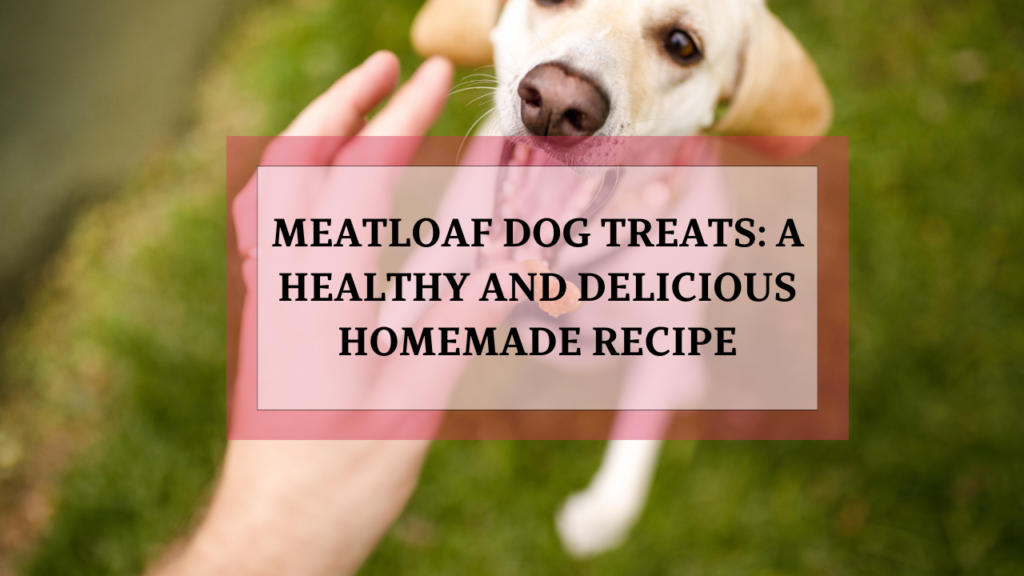Introduction to Meatloaf Dog Treats
Creating homemade treats for your dog is a great way to ensure they’re getting healthy, safe, and delicious snacks tailored just for them. Meatloaf dog treats are an excellent choice for pet owners looking to provide wholesome, nutritious treats without relying on commercial options. These treats are simple to make, packed with nutrients, and can be customized to fit your dog’s dietary needs and taste preferences.
In this post, we’ll explore everything you need to know about meatloaf dog treats—from the health benefits to recipes, ingredient tips, and even variations for special dietary needs. Whether you’re a seasoned cook or new to making pet food, this guide will provide all the information you need to create a delicious treat your dog will love.
Ingredients for Meatloaf Dog Treats
The key to making tasty and nutritious meatloaf dog treats lies in selecting high-quality, dog-safe ingredients. This section provides a detailed list of essential and optional ingredients, along with insights into their health benefits and suitability for different dietary needs.
Essential Ingredients for Basic Meatloaf Dog Treats
To create a foundational meatloaf treat, start with these core ingredients:
- Lean Meat (e.g., Ground Beef, Chicken, or Turkey)
- Provides a high-quality protein source, which is essential for muscle maintenance and energy.
- Helps keep your dog full and supports overall health.
- Eggs
- Acts as a binding agent, giving the treats a firmer texture.
- Eggs are packed with protein, vitamins (like B12), and essential fatty acids.
- Oats or Brown Rice
- These grains are gentle on a dog’s digestive system and offer a slow-release energy source.
- They add fiber, which helps in maintaining healthy digestion.
- Dog-Safe Vegetables (e.g., Carrots, Sweet Potatoes, Green Beans)
- Add nutrients like beta-carotene, vitamins, and fiber.
- Vegetables like carrots and sweet potatoes also add a natural sweetness and are easy on the stomach.
Note: If your dog has specific dietary restrictions, consult your vet before making any changes to the core recipe. For example, grain-free options may substitute oats or brown rice with chickpea flour or cooked lentils.
Optional Ingredients for Flavor and Variety
Adding optional ingredients allows you to customize the meatloaf treats for your dog’s preferences and dietary needs. Here are a few suggestions:
- Herbs (Parsley, Basil)
- Safe in small amounts, herbs can add subtle flavor and, in the case of parsley, even freshen your dog’s breath.
- Pumpkin Puree
- Great for digestion and adds a moist texture to the treats. Pumpkin is also rich in fiber and vitamin A.
- Cheese (in moderation)
- A small amount of low-fat cheese like cottage cheese or mozzarella can add flavor. Be cautious with the amount, as cheese can be high in fat.
Tip: Remember to avoid any herbs or spices that could be toxic to dogs, such as nutmeg. Stick with dog-safe options for flavor enhancement.
Ingredients to Avoid
When preparing any homemade treats, there are certain ingredients to avoid entirely. Some of these can be toxic, while others simply don’t contribute to a healthy diet for dogs.
| Ingredient | Why to Avoid |
| Onions | Toxic to dogs; can damage red blood cells. |
| Garlic | Can cause gastrointestinal upset and, in large amounts, is toxic. |
| Salt | High salt intake can lead to dehydration or sodium ion poisoning. |
| Sugars | Adds empty calories and can lead to weight gain or diabetes. |
| Nutmeg | Contains myristicin, which can be harmful to dogs. |
| Xylitol | Extremely toxic to dogs; can cause hypoglycemia. |
By focusing on natural, safe ingredients, you can ensure that each meatloaf treat not only tastes great but also supports your dog’s health.
Summary of Ingredients
| Category | Examples | Benefits |
| Protein | Ground beef, turkey | Muscle health, energy |
| Grains | Oats, brown rice | Digestion, steady energy |
| Vegetables | Carrots, sweet potatoes | Fiber, vitamins, beta-carotene |
| Optional | Pumpkin, parsley, cheese | Digestion, flavor, added nutrients |
Each of these ingredients brings something beneficial to the recipe, creating a balanced, nutrient-rich snack for your dog.
Step-by-Step Recipe for Meatloaf Dog Treats
Creating meatloaf dog treats at home is a straightforward process that can be done in under an hour. This recipe yields a soft, flavorful meatloaf that can be sliced into treat-sized pieces, perfect for training, snacking, or even special occasions. Here’s a step-by-step guide to making these nutritious treats.
Ingredients
Basic Recipe Ingredients
- 1 lb lean ground meat (such as beef, chicken, or turkey)
- 1 cup rolled oats or cooked brown rice (for fiber and structure)
- 1 large egg (acts as a binding agent)
- 1/2 cup finely chopped carrots (or another dog-safe vegetable, like green beans or sweet potatoes)
- 1/4 cup pumpkin puree (adds moisture and supports digestion)
- 1 tablespoon parsley (optional, helps freshen breath)
Optional Ingredients
- 1/4 cup low-fat cheese (e.g., cottage cheese, mozzarella; for flavor)
- 1/4 cup peas (adds a touch of sweetness and extra fiber)
Note: Feel free to adjust the ingredients to match your dog’s taste preferences or dietary needs. You can substitute oats with chickpea flour for a grain-free version or use different vegetables based on what your dog enjoys.
Instructions
- Preheat the Oven
Preheat your oven to 350°F (175°C) and line a baking pan with parchment paper for easy cleanup. - Mix the Ingredients
In a large mixing bowl, combine the ground meat, oats or rice, egg, chopped vegetables, and pumpkin puree. If you’re using optional ingredients like cheese or parsley, add them now. - Combine Thoroughly
Use a spoon or your hands to mix the ingredients until they are well-combined. Ensure the mixture has an even consistency, as this will help the meatloaf cook evenly. - Form the Meatloaf
Transfer the mixture to your prepared baking pan. Shape it into a loaf approximately 1 to 1.5 inches thick for even cooking. - Bake
Place the pan in the preheated oven and bake for 30–35 minutes or until the meatloaf is firm and cooked through. You can check for doneness by cutting into the center and ensuring there’s no pink meat remaining. - Cool and Slice
Allow the meatloaf to cool completely before slicing it into treat-sized pieces. For smaller dogs, cut into small cubes; for larger dogs, slice into strips or larger cubes. - Storage
Store the meatloaf dog treats in an airtight container in the refrigerator for up to one week. For longer storage, freeze individual portions, which can be defrosted as needed.
Example Recipe Summary
| Step | Action | Tips |
| Preheat Oven | Set oven to 350°F | Preheating ensures even cooking |
| Mix Ingredients | Combine meat, grains, and veggies | Keep consistency even for uniform cooking |
| Bake | Bake 30–35 minutes | Check center for doneness |
| Slice & Store | Slice into desired sizes | Store in fridge for up to 1 week |
Recipe Variations
- Grain-Free Meatloaf: Replace oats with chickpea flour or cooked lentils for a grain-free version.
- Low-Fat Option: Use lean ground turkey and skip the cheese to reduce fat content.
- Extra Fiber: Add a tablespoon of flaxseed for an additional fiber boost, which can support digestion and coat health.
Safety Tip: Always introduce new foods gradually to your dog’s diet, especially homemade treats. Monitor your dog for any signs of food sensitivities or allergies after feeding them these treats.
Homemade meatloaf treats are a nutritious, safe, and delicious option that lets you take control of what goes into your dog’s diet.
Why Choose Meatloaf Dog Treats for Your Dog?
Choosing to make meatloaf dog treats offers a range of benefits, both for your dog’s health and for peace of mind as a pet owner. These treats are often more nutritious, customizable, and budget-friendly than many store-bought alternatives. Here’s why meatloaf dog treats stand out as an ideal homemade option:
Health Benefits of Meatloaf Dog Treats
- Nutrient-Rich Ingredients
Meatloaf treats allow you to pack in essential nutrients from quality protein, vegetables, and whole grains. By selecting ingredients like lean meats, dog-safe vegetables, and oats, you’re providing balanced nutrition that supports muscle health, immunity, and digestion. Unlike many store-bought treats that contain fillers and artificial additives, homemade meatloaf treats can be free from preservatives, excess sugars, and fats. - Easily Customizable for Dietary Needs
Whether your dog has allergies, sensitivities, or specific dietary needs, meatloaf treats are highly versatile. You can swap out ingredients based on your dog’s unique requirements—choosing grain-free, low-fat, or even plant-based options. This customization helps you avoid ingredients that may trigger allergies or digestive issues in sensitive dogs. - Improved Digestibility
Fresh, high-quality ingredients are typically easier for dogs to digest compared to processed ingredients in commercial treats. Using whole ingredients allows for gentler digestion, especially when you include fiber-rich vegetables like carrots or sweet potatoes. Homemade treats can also promote healthy gut flora, especially when you avoid artificial preservatives or colors.
Benefits of Homemade Treats vs. Store-Bought Options
Commercial treats often contain preservatives, artificial flavors, and fillers that don’t provide much nutritional value. Here are some benefits of opting for homemade over store-bought:
- Control Over Ingredients: Homemade treats mean you have full control over every ingredient, ensuring that each item is fresh, safe, and nutritious.
- No Hidden Additives: Many store-bought treats contain salt, sugar, or preservatives to extend shelf life. With homemade treats, you can eliminate these unnecessary additives.
- Cost-Effective: By making treats at home, you can often save money, especially if you buy ingredients in bulk or use seasonal produce.
When Meatloaf Dog Treats Are Especially Beneficial
For some dogs, homemade meatloaf treats are not just a luxury but a necessity. Here are a few examples:
- Dogs with Food Allergies: Many dogs are allergic to common proteins or grains found in commercial treats. With homemade meatloaf treats, you can easily substitute allergens with alternative ingredients.
- Senior Dogs: Older dogs often benefit from softer treats that are easy on their teeth. Meatloaf treats can be made with a softer texture for these dogs, ensuring they can still enjoy a tasty treat.
- Picky Eaters: If your dog is a picky eater, homemade treats let you experiment with different ingredients until you find a combination they love.
By choosing meatloaf dog treats, you’re not only offering your dog a tasty snack but also a nutritious one that supports their overall well-being.
Nutritional Benefits of Meatloaf Ingredients for Dogs
Creating meatloaf dog treats from wholesome, dog-safe ingredients can provide numerous nutritional benefits that support your dog’s health. Let’s break down the key components of these treats—proteins, vegetables, and other nutrient-rich ingredients—and explore how each contributes to a balanced diet for dogs.
Protein Sources
High-quality protein is essential for dogs, as it provides amino acids that support muscle health, energy, and immune function. Including a protein base in your meatloaf dog treats, like lean meats, helps your dog maintain a strong, healthy body.
- Lean Meats (Chicken, Turkey, Beef): These are the most common protein choices for dog treats. Lean meats are lower in fat, reducing the calorie count while still providing protein. They contain essential nutrients, like B vitamins and iron, which help with energy production and cell health.
- Alternative Proteins (Lamb, Fish, Venison): For dogs with allergies to traditional proteins, options like lamb, fish, or venison offer unique amino acids that can benefit dogs with sensitive stomachs or food sensitivities.
Table: Protein Benefits in Meatloaf Dog Treats
| Protein Type | Key Nutrients | Health Benefits |
| Chicken | B vitamins, iron | Boosts energy, supports immune system |
| Beef | Protein, zinc | Maintains muscle mass, aids in healing |
| Fish | Omega-3 fatty acids | Supports coat health, reduces inflammation |
Vegetable Add-Ins for Extra Nutrition
Vegetables are a great addition to meatloaf dog treats, adding vitamins, minerals, and fiber. They not only provide essential nutrients but also improve digestion and add a bit of flavor variety.
- Carrots: Rich in beta-carotene and fiber, carrots support vision health and help maintain regular digestion. They’re also low-calorie, making them ideal for weight management.
- Sweet Potatoes: Loaded with vitamins A, C, and B6, sweet potatoes help boost the immune system and are gentle on the digestive tract.
- Peas: Peas contain potassium, fiber, and protein, making them a great addition to meatloaf dog treats for a nutritional boost.
Including vegetables in dog treats can be particularly beneficial for dogs who may not otherwise consume enough fiber, aiding in healthy digestion and nutrient absorption.
Other Nutrient-Rich Ingredients
In addition to proteins and vegetables, there are other ingredients you can include in meatloaf dog treats to boost nutrition and add variety.
- Oats: A high-fiber, gluten-free grain that supports heart health and provides lasting energy. Oats are especially beneficial for dogs with sensitive stomachs, as they’re gentle on the digestive tract.
- Herbs (Parsley, Rosemary): Some herbs can be beneficial for dogs. For instance, parsley is known to freshen breath and is safe in small amounts, while rosemary provides natural antioxidants.
Example of Nutritional Composition in a Meatloaf Dog Treat Recipe:
| Ingredient | Key Nutrients | Health Benefits |
| Carrots | Beta-carotene, fiber | Supports vision health, aids digestion |
| Sweet Potatoes | Vitamin A, vitamin C | Boosts immune system, gentle on digestion |
| Oats | Fiber, iron | Heart health, steady energy levels |
Tip: Always ensure vegetables and grains are cooked or lightly steamed before adding them to dog treats, as this makes them easier for dogs to digest and absorb nutrients.
Ingredients to Avoid
While meatloaf dog treats can be highly nutritious, some ingredients are not safe for dogs and should always be avoided:
- Onions and Garlic: Both can be toxic to dogs and may cause gastrointestinal upset or even more severe health issues.
- Salt and Sugars: These add unnecessary calories and may lead to health problems over time, like obesity or diabetes.
- Spices like Nutmeg: Certain spices, like nutmeg, can be harmful to dogs and should be kept out of all dog recipes.
Choosing nutrient-dense ingredients ensures that each bite provides your dog with valuable nutrients while avoiding ingredients that may compromise their health.
Benefits of Homemade Dog Treats Over Store-Bought Options
When it comes to treating your furry friend, the debate between homemade and store-bought options is significant. While store-bought dog treats offer convenience, homemade meatloaf dog treats provide several compelling advantages that can enhance your dog’s health and well-being.
Health and Quality Control
One of the primary benefits of making homemade dog treats is the ability to control the ingredients. With homemade treats, you can choose high-quality, nutritious components that cater to your dog’s specific dietary needs. Many commercial treats contain additives, fillers, and preservatives that may not only be unhealthy but can also contribute to allergies or digestive issues in sensitive dogs.
- Fresh Ingredients: By using fresh, whole ingredients like lean meats and vegetables, you ensure your dog gets optimal nutrition. Unlike many store-bought options, homemade treats can be made from ingredients you recognize and trust.
- Customization: Every dog is unique, and some may have dietary restrictions or preferences. With homemade treats, you can tailor recipes to suit your dog’s health needs, whether they require low-fat options, grain-free ingredients, or special proteins due to allergies.
Avoidance of Preservatives and Fillers
Many commercial dog treats are loaded with preservatives to extend shelf life and fillers to bulk up the product. While these may keep the treats on the shelf longer, they often do not add any nutritional value.
- No Hidden Ingredients: When you make treats at home, you know exactly what goes into them. You can avoid common harmful ingredients like artificial flavors, colors, and preservatives such as BHA, BHT, or ethoxyquin.
- Natural Flavor: Homemade treats can also be more appealing to your dog due to the use of natural ingredients. Your dog is more likely to enjoy a treat made from real meat and wholesome vegetables than one filled with artificial additives.
Cost-Effectiveness and Personal Satisfaction
While there’s an upfront time investment in making homemade treats, they can ultimately be more cost-effective than purchasing premium store-bought options.
- Bulk Buying: Purchasing ingredients in bulk can save money, especially when preparing larger batches of treats. Plus, homemade treats can be made at a fraction of the cost of high-quality commercial options.
- Personal Satisfaction: There’s something incredibly rewarding about crafting your dog’s treats from scratch. Not only does it allow you to bond with your pet, but knowing that you are providing healthy, homemade goodness can bring immense satisfaction. Your dog will likely appreciate the effort, responding with wagging tails and eager appetites.
Conclusion
In conclusion, homemade meatloaf dog treats offer substantial health benefits, allow for greater control over ingredients, and provide a satisfying alternative to store-bought options. By opting for homemade treats, you ensure your furry friend enjoys wholesome, safe, and delicious snacks tailored to their needs. As we move forward, let’s dive deeper into the specific nutritional benefits that the ingredients of these meatloaf treats can provide for your dog.



